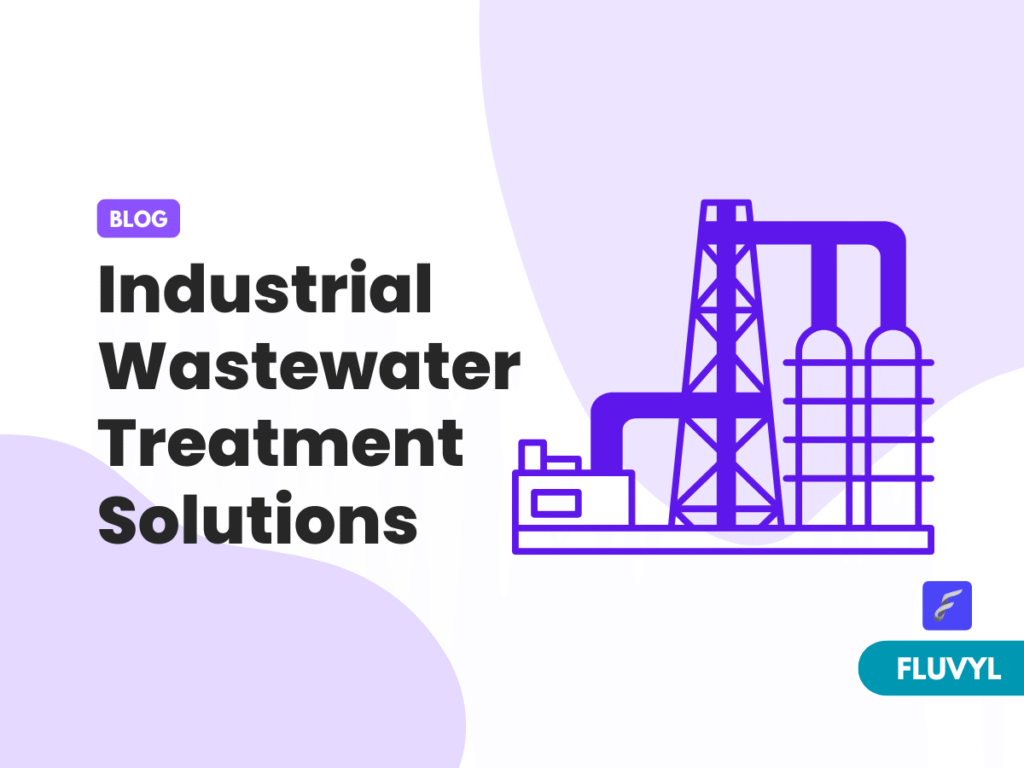10 Proven Methods for Wastewater Treatment Optimization

By Fluvyl, updated Apr 10, 2025

Industrial wastewater treatment solutions are becoming increasingly vital as environmental regulations tighten and sustainability goals rise across industries. From textiles and food processing to oil refineries and chemical plants, every industrial process that uses water generates wastewater that must be treated before being released or reused.
In this comprehensive blog, we’ll dive deep into the world of industrial wastewater treatment solutions, exploring the sources of industrial wastewater, treatment technologies, challenges, innovative approaches, and how industries can implement effective treatment strategies. Tables are included to provide clarity and comparison.
Synopsis
Why Industrial Wastewater Treatment Solutions Matter
- They prevent pollution and protect ecosystems.
- They help industries comply with environmental regulations.
- They enable water recycling and resource recovery.
- They improve public health and environmental safety.
- They support long-term sustainability and ESG goals.
If your facility is seeking the right industrial wastewater treatment solutions, consider a holistic approach: assess your effluent, consult with experts, choose scalable technologies, and invest in automation for efficiency.
1. What is Industrial Wastewater?
Industrial wastewater refers to the liquid waste generated from manufacturing or industrial processes. Unlike domestic wastewater, it contains a high concentration of chemicals, heavy metals, organic matter, and other pollutants.
Industrial wastewater treatment solutions are designed to remove or neutralize these pollutants so the water can be safely discharged or reused.
2. Why Treatment is Necessary
Untreated industrial wastewater can contaminate soil, groundwater, rivers, and marine environments. It can also pose health risks to humans and wildlife.
Key Benefits of Treatment:
- Environmental Protection: Prevents pollution and ecosystem degradation.
- Regulatory Compliance: Avoids legal penalties and shutdowns.
- Resource Recovery: Recovers valuable byproducts like oils, metals, and heat.
- Water Reuse: Supports sustainable water use practices.
Thus, industries rely on industrial wastewater treatment solutions not only to meet legal standards but to align with corporate responsibility and sustainability goals.
3. Sources and Types of Industrial Wastewater
Each industry produces wastewater with different characteristics. Understanding the source helps in selecting the right treatment solution.
Table 1: Common Sources of Industrial Wastewater
| Industry | Major Pollutants | Flow Characteristics |
|---|---|---|
| Textile | Dyes, salts, BOD, COD, surfactants | High pH, color, high TDS |
| Food & Beverage | Fats, oils, organic waste, starch | High BOD, fluctuating pH |
| Chemical Manufacturing | Toxic organics, acids, solvents | Variable load and toxicity |
| Oil Refineries | Hydrocarbons, heavy metals, sulfides | High COD, oily |
| Pulp & Paper | Lignin, chlorine, suspended solids | High BOD, fibrous waste |
| Pharmaceutical | Antibiotics, APIs, pH-altering agents | High chemical load |
4. Key Components of Industrial Wastewater Treatment Solutions
A robust treatment system involves several stages and components. Here’s a breakdown of essential elements:
Table 2: Components of Treatment Systems
| Component | Function |
|---|---|
| Screening | Removes large solids |
| Equalization Tank | Balances pH and flow rate |
| Neutralization Unit | Adjusts pH levels |
| Coagulation/Flocculation | Settles suspended solids |
| Biological Treatment | Breaks down organic matter |
| Filtration | Removes fine particles |
| Disinfection Unit | Eliminates pathogens |
| Sludge Handling Unit | Treats and disposes sludge |
Each of these plays a crucial role in comprehensive industrial wastewater treatment solutions.
5. Primary, Secondary, and Tertiary Treatments
Treatment systems are generally classified into three levels:
5.1 Primary Treatment
- Removes floating materials and settleable solids.
- Involves screening, grit removal, and sedimentation.
- Prepares the wastewater for biological processes.
5.2 Secondary Treatment
- Uses microorganisms to degrade dissolved organic matter.
- Common methods: Activated Sludge, Trickling Filters, MBBR.
- Effective in reducing BOD and COD.
5.3 Tertiary Treatment
- Advanced processes to polish the effluent.
- Involves membrane filtration, activated carbon, or ion exchange.
- Ensures high-quality discharge or reuse.
The integration of all three stages forms the backbone of effective industrial wastewater treatment solutions.
6. Modern and Advanced Treatment Technologies
Advancements in treatment technologies are making systems more efficient and environmentally friendly.
Table 3: Advanced Technologies Overview
| Technology | Description | Benefits |
|---|---|---|
| Membrane Bioreactors (MBR) | Combines biological & membrane filtration | Compact, high effluent quality |
| Electrocoagulation | Uses electricity to remove contaminants | Reduces chemical usage |
| Advanced Oxidation Process (AOP) | Uses radicals to degrade toxins | Effective on non-biodegradable pollutants |
| Reverse Osmosis (RO) | Pressure-based filtration | High TDS removal |
| Constructed Wetlands | Mimics natural wetlands for treatment | Sustainable, low-energy |
Incorporating these into industrial wastewater treatment solutions can improve performance while reducing operational costs and footprints.
7. Challenges in Industrial Wastewater Treatment
Implementing efficient solutions is not without its challenges.
Common Challenges:
- Variability in Effluent Composition: Sudden changes in wastewater characteristics can affect treatment efficiency.
- High Capital and Operating Costs: Advanced technologies often require significant investment.
- Sludge Management: Disposal and handling of sludge remain a major issue.
- Space Constraints: Especially in urban or brownfield sites.
- Skilled Workforce Requirement: Expertise is needed for system operation and maintenance.
Despite these, industries are actively seeking industrial wastewater treatment solutions that balance efficiency, sustainability, and cost.
8. Industry-Specific Treatment Solutions
Let’s explore how treatment solutions are customized for different sectors:
Table 4: Sector-wise Treatment Solutions
| Industry | Treatment Approach |
|---|---|
| Textile | Equalization → Coagulation → Biological → RO |
| Dairy | Anaerobic Digestion → Aerobic → Filtration |
| Pharmaceutical | AOP → Activated Carbon → UF/RO |
| Petrochemical | Dissolved Air Flotation → Biological → Polishing |
| Metal Finishing | pH Adjustment → Precipitation → Ion Exchange |
These specialized industrial wastewater treatment solutions are tailored to meet specific regulatory norms and reuse goals.
9. Cost Analysis and Efficiency
Understanding the economics of wastewater treatment helps industries plan better.
Table 5: Cost vs. Treatment Efficiency
| Treatment Type | CAPEX ($/m³/day) | OPEX ($/m³) | Removal Efficiency |
|---|---|---|---|
| Conventional Activated Sludge | 200–400 | 0.3–0.5 | 85–90% BOD/COD |
| MBR | 500–800 | 0.5–0.8 | >95% |
| AOP | 600–1200 | 0.6–1.2 | >90% |
| Constructed Wetlands | 150–300 | 0.1–0.3 | 70–85% |
Careful planning and selection can help industries find industrial wastewater treatment solutions that are both cost-effective and compliant.
10. Sustainable and Smart Solutions
Sustainability and digital transformation are reshaping how industries treat wastewater.
Smart and Sustainable Practices:
- Water Reuse & Recycling: Treated water is reused for cooling, cleaning, or irrigation.
- Zero Liquid Discharge (ZLD): Ensures no liquid waste leaves the premises.
- Internet of Things (IoT): Enables real-time monitoring and control.
- AI and Machine Learning: Optimize process parameters and predict failures.
- Energy Recovery Systems: Anaerobic digesters convert waste into biogas.
These innovations are transforming traditional systems into intelligent industrial wastewater treatment solutions that reduce waste, lower costs, and support circular economy models.
Final Thoughts
Industrial activities are critical to economic development, but they must be managed responsibly. Implementing efficient, compliant, and innovative industrial wastewater treatment solutions is not just an environmental necessity—it’s a strategic advantage.
Whether it’s minimizing costs, meeting discharge standards, or achieving water reuse goals, modern solutions offer industries the flexibility to grow sustainably. With advancements in treatment technologies and the integration of digital tools, the future of industrial wastewater management looks promising and green.
